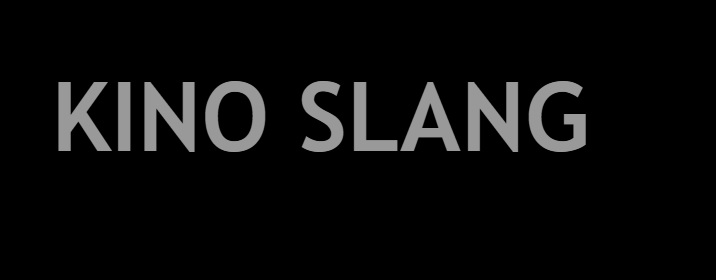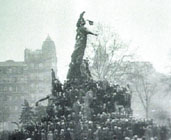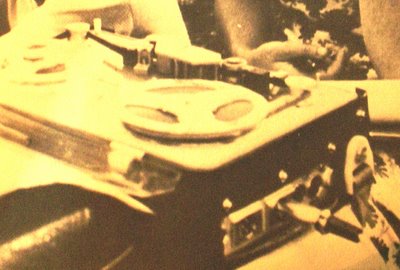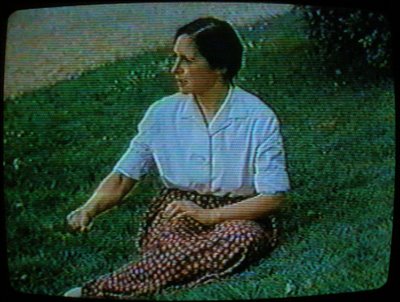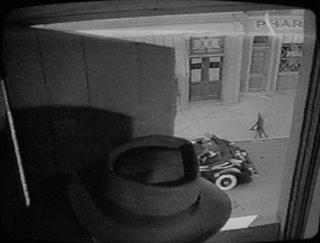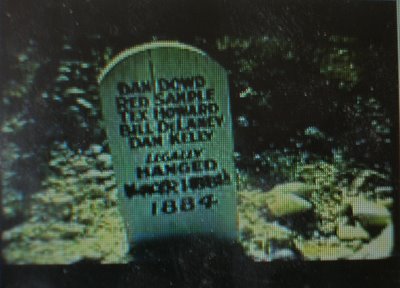at his feet
of the unanimous horizon
that there
prepares itself
is tossed and mingles
with the fist which would grasp it
as one threatens
a destiny and the winds
the one number which cannot
be another
Spirit
to pitch it
into the tempest
refold its division
and pass on proudly
(from Toute révolution est un coup de dés
[Every Revolution is a Throw of Dice]
1977, Straub/Huillet
Danièle Huillet sits at Père-Lachaise Cemetary, with the slain Communards of 1871 underfoot, reciting Mallarmé's poem Coup de dés of 1897:
(...)
de cette conflagration
à ses pieds
de l'horizon unanime
que se
prépare
s'agite et mêle
au poing qui l'étreindrait
comme on menace
un destin et les vents
l'unique Nombre qui ne peut pas
être un autre
Esprit
pour le jeter
dans la tempête
en reployer la division et passer fier
(...)
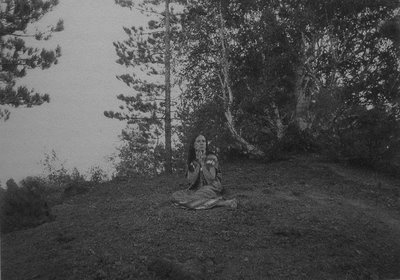
(Danièle in Schwarze Sünde [Black Sin], 1988, Straub/Huillet)

(Danièle at the Vienna Filmmuseum, 2004)
When I attended the Viennale/Filmmuseum retrospective in 2004, it was my first and only chance to have met Huillet; I failed. I watched her a little in the lobby, she was rather aloof to all the reunions, drinks and commotion of that first night of their arrival. During the panel she interjected with her typical clarity and sobriety, and smiled and laughed when the subject wasn't peasant wars, a bad book on Cézanne by John Rewald, pieds-noir (French colonialists in Algeria), Bush.....She made one of the most trenchant and relevant comments to why the "rules of the game" are such as they are with their films, with their political stakes, with their extreme interest in the films of John Ford. She said:
"Everything has a motive, in the military too. They are not devils or criminals. It's too easy to say Bush is crazy — to understand the thing is the only way to combat it, not to apologize for it. In Bush you know what you're dealing with, with progressives you don't always know."
Several nights later, before either a screening of Dr. Bull (1933, John Ford) or Too Early, Too Late (1978), I saw her quietly buying a copy of JOHN FORD: INTERVIEWS while everyone hobknobbed, holding it between her arm and her chest the rest of the evening.

(Huillet and Straub shooting Il Ritorno del figlio prodigo/Umiliati [Return of the Prodigal Son/Humiliation] 2003, Huillet/Straub.)
For me, at this moment, there's no point in trying to delineate what was
Huillet and what was
Straub in their films. They worked together on every film, including the early ones where only Straub is credited. One look at Pedro Costa's film
on Huillet/Straub's work ethic
Ou git votre sourire enfoui? (
Where Lies Your Hidden Smile?) will show you that while Jean-Marie is a raging current, Danièle also drives the turbines
and maintains the power station. Perhaps an industrial metaphor is too crude; as a child Huillet wanted to be a peasant farmer, then a veternarian (Huillet on
The General Line:
"if you're going to say that tractors are extremely useful you should also mention the damage they cause....You can't help thinking that he [Eisenstein] didn't follow his work to its conclusion." ). In any case, there's no need for the forthcoming obituaries and articles to treat her role as secondary. It's also worth noting that every poster for their films since
Antigone (1991) is printed "Film de Danièle Huillet et Jean-Marie Straub".
Of course one is interested in the facts about their precise roles in the creation and execution of some of the greatest works of all of cinema, but eternal inaccessability to Huillet/Straub's personal/craft dynamic aside (can one really trace these kinds of dialectics? Or perhaps it's Sam Fuller's "third face"?), maybe we'd do better to remember Huillet's words:
"we are interested in the products not the names"
or even:
"Ultimately, about Pavese himself we couldn't care less by the end of the film. What interests us are the good people who say Pavese's texts, what they do in life, how they say these texts, the problems they have saying what they say – which makes what they say all of sudden no longer belong to Pavese but to the good people who say it – who at the outset had never heard of Pavese. The only interest that the text or what you call the culture has is that the person who wrote it did a certain work, he produced something which touched us and which subsequently has resisted – from which one can judge that he did his work well.”
This weighing of all consquences, be it in their use of a Pavese text and all the reverberations of how, who and why; be it with animals, camera distances, political terms (D: "But one can't use the term “fascist” loosely. It’s a precise term, with a certain historical meaning"); agit-prop films (D: "it's not worth making such films out of anger, either. Rage. Fury."); ultimately one's own subjectivity (D: "Of course we react to circumstances, as individuals. But that's not a good enough reason to insert these individual reactions into a film, for it would bring us back to sentimentatlity." ) -- in all this the work will live. Though at this painful moment this no consolation for the loss of such an artist.
But, too, Danièle Huillet wasn't some provincial puttering old woman in the end, in fact she leaves at least one project up in the air, and two recent
finished films sadly unaccompanied. She (along with Straub of course) not only had the new film
Quei loro incontri (2006) about to open in Paris, which they planned to accompany, but also planned to shoot yet another film in the coming months, with cast and crew arranged, to be shot in the Loire region of France. Then there's their 12 minute short film
EUROPA 2005, 27 OCTOBRE (2006), shot last spring and, though it may be shown as an anonymous
cine-tract, it will screen along with 4 of their Italian films at the
Villa Medici on October 21st. The film was commisioned by Enrico Ghezzi as a "sequel" to Rossellini's
EUROPA '51 and the "27 OCTOBRE" of the title refers to the day two teenagers (Bouna Traore, 15, and Zyed Benna, 17) were electrocuted and killed while hiding from the police in an electric station - the event that sparked the uprising in France last year.
Huillet, Straub and two other filmmakers shot the movie on digital video (their first) on the site of the teen deaths, in the suburb Clichy-sous-Bois.
***
oder WENN DANN DER ERDE GRÜN VON NEUEM EUCH ERGLÄNZT!
